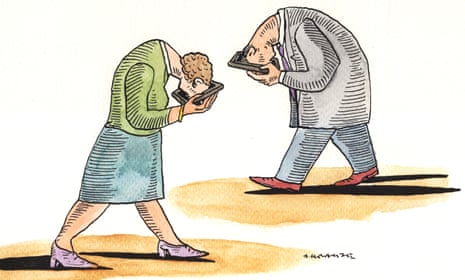There is a lot to like about the Latif test. Like the driving test, and that one that involves sticking a knife in a cake and seeing if it comes out sticky, it is undeniably useful. Checks and balances may well be needed to help curb Hollywood prejudice. And unlike most other tests – IQ, STD, GCSE – it is pithy, on-point and wittily written.
Devised by two sisters from London, Nadia and Leila Latif, it aims to gauge a film’s latent racism by levelling at it a series of questions. These include: are there two characters of colour in the film? Do they have names? Do they speak? About something other than a white hero? And – just to check – are they definitely not magic?
Three cheers for this sort of light-touch lawfulness. Suggested early in the production process, such steers would undoubtedly be instructive. But I’m less keen on its willy-nilly wheel-out; likewise a boycott of those movies that don’t make the grade – or the bodies that give them prizes.
Writing in the Guardian earlier this week, the Latifs bemoaned the fact that when you examine this year’s best-picture Oscar nominees, three of them pass (The Big Short, The Martian and The Revenant), two fail (Mad Max and Room), and, worst of all, three do not contain a single named character of colour (Bridge of Spies, Brooklyn and Spotlight).
Yet sometimes to fail is more dignified than to triumph. All three of the worst offenders are period pieces. Two are based, pretty strictly, on real-life events. Colour-blind casting would be odd in Spotlight (Boston Globe reporters uncover a ring of paedophile priests) and in Bridge of Spies (Washington lawyer negotiates a cold-war prisoner swap in Berlin). Brooklyn is set in 1952, half in a small village in County Wexford and half in an Irish expat boarding house run by Julie Walters.
For many decades cinema botched this issue spectacularly. It worked on the assumption that audiences don’t see colour – as long as the actors are white. John Wayne played Genghis Khan and Charlton Heston Moses. It is only relatively recently that eye-rolling over such casting replaced blind acceptance. Now such oversight is glaring – and can be fatal.
Joel Egerton’s Egyptian pharaoh in Exodus: Gods and Kings cost the movie dear; likewise Emma Stone’s Hawaiian in last year’s Aloha. The Latif test is admirably trying to redress the balance. But if enforced to the extreme, it risks being a retrograde step.
Nowadays, to sacrifice accuracy in the service of diversity is not just iffy – it is counterproductive. It undermines the achievement of movies such as 12 Years a Slave, Steve McQueen’s best-picture Oscar-winner, whose power derives in part from its scrupulous truthfulness. To randomly slot characters into stories that would have been different had they been present is to tell a lie.
And once you abandon historical context, you limit comprehension. When this is lost, learning is curtailed and progress threatened. People did things differently then. If we don’t acknowledge this – as well as the fact 2016 may not be the endpoint of human tolerance and understanding – we may find ourselves in an endless, goldfish present in which we forever thud our skulls against the walls of the tank.
But this is the destination we are hastening towards anyway. Living for the moment isn’t just the motto we’re meant to yell as we bungee happily off a cliff, it is an inevitable product of our conditioning. We are saturated in facts, in a news churn that makes us fidgety when faced with anything without obvious reference to our own experience.
The engine for this – the echo chamber of social media – is also what encourages people to insist the Latif test be followed to the letter. It is Twitter that cannot only prompt people to grip the wrong end of the stick, but also validates their muddle-headedness. By the time we’ve reached the stage of #OscarsSoWhite in the Hollywood race debate, it is too late – the very end of the process. Not just of film production but of history so far itself – a history that has invariably been cruel, unfair and imperialist.
Our insistence that the past not offend the present is another iteration of our apparently insatiable desire for art that reflects the contemporary. The sleeper movie hits of this year have been Ex Machina, a sci-fi set in the present day that tackles an issue that troubles many gamers (should I trust a sexy robot?) and The Big Short, in which Ryan Gosling fills us in on what actually happened during the 2007-08 financial crash.
On TV, we lap up Making a Murderer. On radio, we are addicted to Serial. Soaps seem thin unless propped up by real death and heartbreak. The digital revolution has left us increasingly incapable of processing fiction. Daydreaming is defunct now we all have phones to scroll. The creativity of childhood has been replaced by the prescribed fantasies of PlayStation. What stories there are carefully accommodate current teen concerns: what if my best mate fancies the same girl as me (Harry Potter)? How will I be received if I go on a reality show (The Hunger Games)? And so the fishtank shrinks a little tighter.
So it is heartening that the movie that will actually win all the Oscars this year isn’t just one of the three that passes the Latif test; but is also the only film on the list truly born of the dream factory. The Revenant is a film that does not appear interested in providing contemporary resonance. Instead, it seems to seek to tap into subconscious. It winches our eyes up to the stars, its vision untethered to earthy concerns.
How do we respond? By remorselessly hauling it into the present day. We ask Ray Mears to tell us how feasible sleeping in a horse carcass really is (buffalo would have been better), and whether raw bison liver would be a wise supper choice if you were starving to death (yes). We enrol on tie-in survival courses run by the Bear Grylls academy on the outskirts of Luton. We tell each other that Leonardo DiCaprio got cold on the shoot, and that the big mountain of skulls was actually Styrofoam.
For me, the key image of this year’s Oscar race so far emerged last week. It’s of Glenn Ennis, a 6ft 4in stuntman who played the bear that attacks DiCaprio in one of the movie’s most extraordinary scenes. Ennis grins beneath his blue suit and hockey mask; on top of his hair is a crude, papier-mache bear’s head, like a homemade piñata, also painted blue.
We just can’t cope with not knowing, can we? We just have to keep it real.

